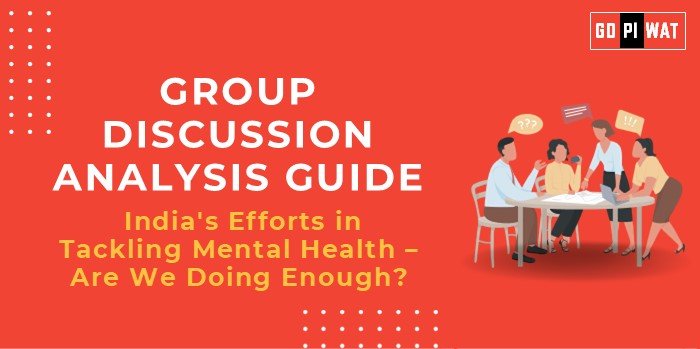📋 Group Discussion (GD) Analysis Guide
🌐 India’s Efforts in Tackling Mental Health – Are We Doing Enough?
📄 Introduction
Opening Context: Mental health issues in India are gaining much-needed attention as a rising public health concern, with approximately 10.6% of the adult population suffering from mental disorders. The Mental Healthcare Act 2017 marked a significant policy advancement, but are these efforts sufficient to address the vast treatment gap?
Background: India faces significant challenges in mental health, including stigma, inadequate infrastructure, and a severe shortage of professionals. Addressing these challenges is crucial for ensuring well-being and societal progress.
📊 Quick Facts and Key Statistics
- Mental Health Disorders: 10.6% of India’s adult population suffers from mental health disorders.
- Treatment Gap: Between 70% and 92% of individuals with mental health conditions lack access to adequate care.
- Mental Healthcare Act 2017: Decriminalizes suicide and guarantees access to mental health services.
- Budget Allocation: ₹919 crore allocated to mental health in 2023-24, constituting 1.03% of the total health budget.
- Workforce Gap: Only 0.75 psychiatrists per 100,000 people, far below WHO recommendations.
👥 Stakeholders and Their Roles
- Government: Provides legal and financial support, such as the National Mental Health Programme.
- Private Sector: Offers therapy and online counseling platforms like Wysa and YourDOST.
- NGOs and Advocacy Groups: Work to reduce stigma and promote mental health awareness.
- Academic Institutions: Integrate mental health education and offer on-campus counseling.
📈 Achievements and Challenges
- Achievements:
- 📜 Legislative Milestones: Implementation of the Mental Healthcare Act 2017.
- 📢 Awareness Efforts: National and grassroots campaigns reducing stigma.
- 💻 Tech Interventions: Platforms like iCall and telehealth services providing accessible care.
- Challenges:
- 💸 Funding Constraints: Only 1.03% of the health budget is dedicated to mental health.
- 📉 Workforce Shortages: The psychiatrist-to-population ratio remains abysmal.
- 🏘️ Rural Gaps: Limited infrastructure and accessibility in rural areas.
✨ Effective Discussion Approaches
- Opening Approaches:
- 📊 “Approximately 10.6% of India’s adult population suffers from mental disorders, with up to 92% untreated. How can we close this gap?”
- 📜 “The Mental Healthcare Act 2017 decriminalized suicide but is yet to address the systemic gaps in mental health delivery.”
- Counter-Argument Handling:
- 💡 Address funding and workforce issues by suggesting public-private partnerships or digital solutions.
🔑 Strategic Analysis of Strengths and Weaknesses
- Strengths: Legislative progress, increasing public awareness, growth of digital platforms.
- Weaknesses: Limited budget allocation, professional shortages, high stigma levels.
- Opportunities: Leveraging AI and telemedicine, integrating mental health into primary care.
- Threats: Rising untreated cases leading to societal and economic burdens.
⚖️ Structured Arguments for Discussion
- Supporting Stance: “India’s Mental Healthcare Act 2017 represents a progressive step towards decriminalizing suicide and ensuring access to care.”
- Opposing Stance: “With treatment gaps exceeding 70%, India’s mental health infrastructure and funding remain insufficient.”
- Balanced Perspective: “While policy advancements are commendable, effective implementation and funding are crucial for meaningful impact.”
📚 Connecting with B-School Applications
- Real-World Applications: Mental health analysis as a case study in healthcare management.
- Sample Interview Questions:
- 🤔 “What strategies can India adopt to address the mental health workforce gap?”
- 💻 “How can digital solutions like telehealth improve access to mental health services?”
- Insights for Students: Mental health is essential for employee well-being, productivity, and workplace culture.


